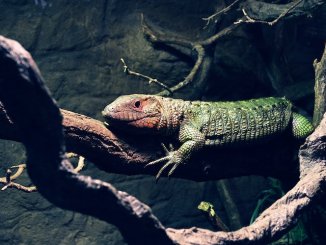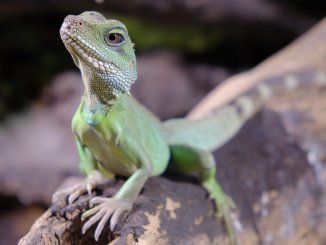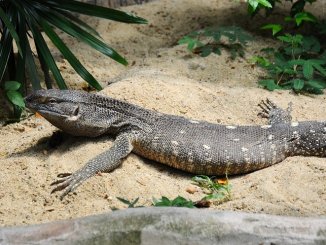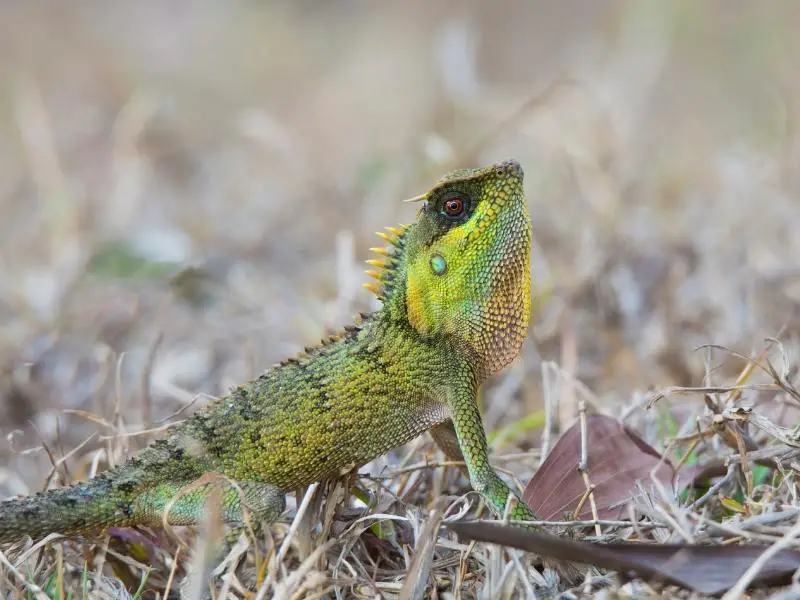
The mountain horned lizard is a medium-sized lizard reaching up to 12 inches in length. Mountain horned lizards have grey-colored skin with orange, red, or yellow markings. These lizards are also recognized by their large spines with noticeable dorsal spines running from the top of the reptile’s neck to its tail. Mountain horned lizards are arboreal lizards living in humid forests in Southeast Asia, including countries like Thailand, Myanmar, Vietnam, and Cambodia.
Mountain horned lizards are hardy pets that require minimal care and attention from their owners, making them an excellent choice for a beginner. Also known as a mountain horned dragon, this species is calm and docile, as well as easy to care for.
Mountain Horned Lizard Overview
| Common name | Mountain horned lizard, mountain horned dragon |
| Scientific name | Acanthosaura capra (A. capra) |
| Natural habitat | Humid tropical forests |
| Adult size | 12 inches |
| Average lifespan | 8–10 years |
| Diet | Insectivorous |
| Housing | Terrarium |
| Experience | Beginner/Intermediate |
Origin
The mountain horned lizard is a species endemic to rainforests of Southeast Asia. Mountain horned lizards live in forested areas in countries like Thailand, Myanmar, Vietnam, and Cambodia. These reptiles are arboreal creatures that mainly live in tree branches. The natural habitat of these lizards is represented by high levels of humidity, medium to high temperatures, and rich vegetation, typical for tropical forests in the region.
Mountain horned dragons are the most common lizards in the genus Acanthosaura which includes as many as 10 different species. These reptiles are caught in the wild for the pet trade where they are also abundant.
Appearance and Behavior
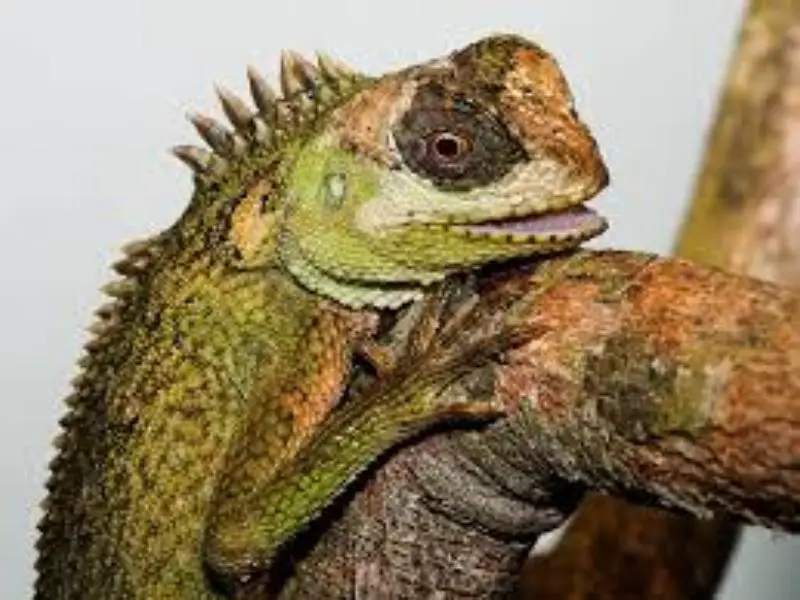
The mountain horned lizard typically has a grey- or brown-colored body with some colorful spots, which can be red, orange, or yellow. Some reptiles have bright green bodies and brighter spots, depending on the variety. The lizard’s body is slim and long, and its tail tends to be longer than the body. The animal is recognized by the characteristic shape of its spine which extends over the surface of its back, running from the head to the end of the tail.
Male and female mountain horned lizards are very similar in coloration which makes it difficult to establish the sex of the animal by looking at its color. However, male mountain horned lizards have a broader tail base compared to females. In addition, there are two visible bumps at the base of the male’s tail.
Size and Lifespan
A mountain horned lizard is a medium-sized reptile reaching 12 inches in length in adulthood. Female mountain horned lizards tend to be smaller, at around 10 inches in length when reaching maturity. Mountain horned lizards reach maturity at the age of 18 months.
The mountain horned dragon may live up to 10 years in captivity if the conditions are appropriate and match their natural habitat. However, little is unknown about the species’ lifespan in the wild.
Temperament
Mountain horned lizards have specific behaviors that their owner should be aware of. They are calm reptiles that remain motionless for long periods of time, which is behavior they use to hunt insects in their natural habitat. Mountain horned lizards may also stay without movement when they perceive danger.
The mountain horned lizard is considered an easy-to-care-for and tranquil species that might allow moderate handling. These reptiles can get aggressive with each other which is why it’s best to introduce the lizards to each other slowly and with care. Two mountain horned dragons can be housed together but, because they grow up to be quite large, each reptile needs a lot of space to feel secure. The owner needs to keep in mind that there’s no guarantee two mountain horned dragons will get along together.
Housing Mountain Horned Lizard
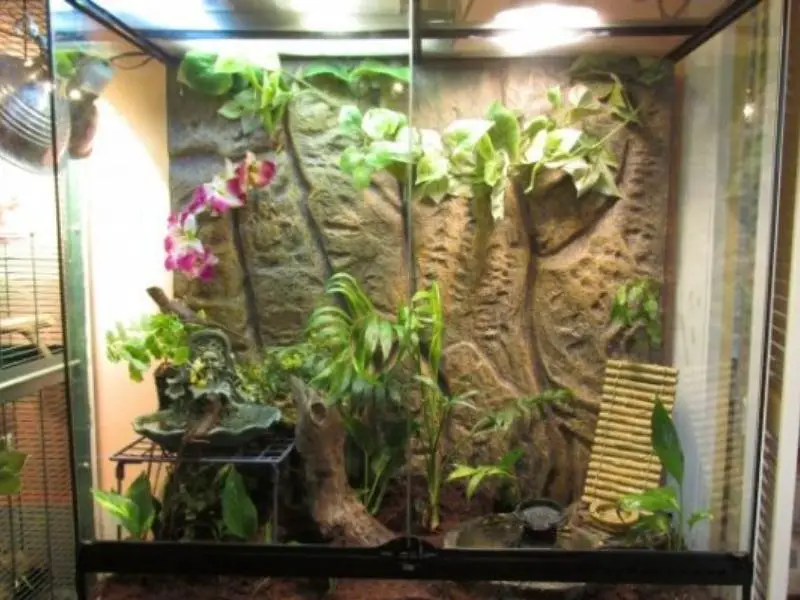
A mountain horned lizard is native to tropical forests of Southeast Asian countries where they live in conditions of high humidity, moderate temperatures, and an abundance of vegetation. These conditions need to be recreated in their enclosure at home to make the reptiles feel happy and safe. Mountain horned lizards are most likely to thrive in a large enough terrarium made of thick glass.
Enclosure size
Mountain horned lizards thrive in glass terrariums that provide them with enough space to move around and hide in the plants. One lizard can be housed in a vertically-oriented terrarium that is 18 inches long, 18 inches wide, and 36 inches tall.
Because these lizards tend to live at the tops of the trees in their natural habitat, it’s best to give them an enclosure where they can climb to the top and feel far away from the ground. Mountain horned lizards also require a screen top on their terrarium.
Lighting
Mountain horned lizards require full-spectrum lighting that mimics the natural light cycle characteristic of their natural habitat. The best way to do so is to introduce functional UVB lighting in the terrarium to help the lizard synthesize vitamin D to stay healthy. Mountain horned lizards should be exposed to 5% UVB lighting between eight and 12 hours a day. Make sure to change UVB lights every six to eight months because the length of light penetration tends to shorten over time which might affect the health of the pet negatively.
Temperature and Humidity
Mountain horned lizards are species that enjoy moderate temperatures and high humidity in their enclosure. Mountain horned lizards need a change in temperatures throughout the day to reflect the conditions of their natural habitat, with 78°F to 81°F during the day, and around 70°F at night. It’s important to make sure that the temperature in the terrarium or vivarium does not go above 86°F to help the lizard stay cool enough.
To maintain the appropriate temperatures in the tank, consider introducing a heating pad to the tank. Create a basking space for the mountain horned lizard by placing a heating lamp above the space where the temperature should be at the level of 80°F.
Mountain horned lizards are used to the conditions of high humidity. An ideal humidity level at the enclosure is between 70% and 75%. This level can be achieved by misting the terrarium twice a day or by introducing a misting system.
Substrate and Decoration
A mountain horned dragon needs a substrate that holds moisture well, helping to maintain an appropriate level of humidity in the tank. Compressed coconut substrate or cypress mulch are both good options for a mountain horned lizard tank.
Mountain horned lizards require a large water container to support humidity levels and allow the reptiles to soak whenever they need to. Mountain horned lizards only recognize running water which means a water pump should be placed in a container. Alternatively, a small decorative waterfall can be placed in the tank.
To decorate the terrarium, make sure to add a variety of live and artificial plants to recreate a familiar atmosphere for the lizard. Mountain horned dragons enjoy plants with thick branches. Some of the best options for terrarium decoration for a mountain horned lizard are ferns, pothos, philodendrons, palms, and orchids. The stronger the plant, the more likely the lizard is to climb it.
Cleaning
A mountain horned lizard’s tank does not require rigorous cleaning, making these reptiles an easy pet. Clean any visible spots on the glass walls of the tank regularly and make sure to change the water bowl daily, because mountain horned lizards may defecate in it. Clean the entire tank once every two months using a weak dishwashing liquid dilution with warm water and scrub all decorations.
When doing a deep clean, move the reptile into a separate container where it can stay for a while. Make sure to wash your hands before and after handling the reptile to prevent the spread of diseases and infections.
Mountain Horned Lizard Care
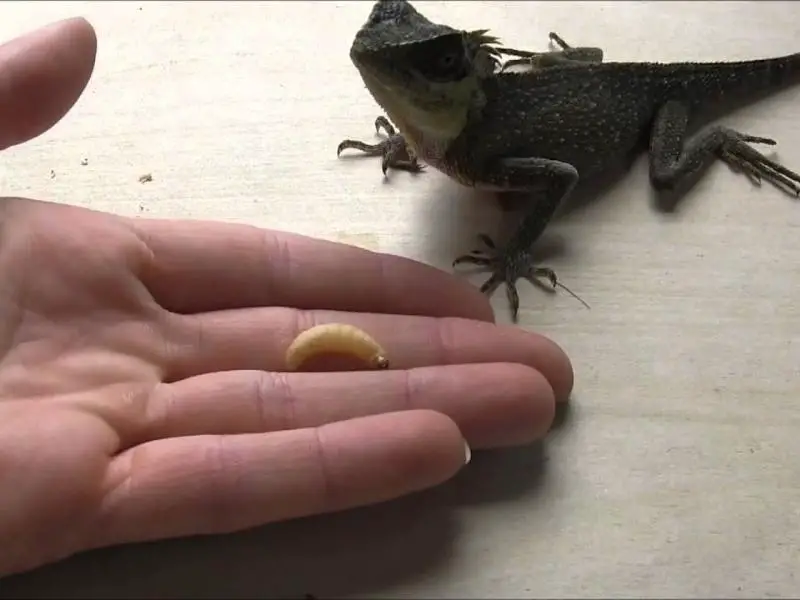
The mountain horned lizard is a suitable pet for a novice owner because it has few specific requirements when it comes to its care. A mountain horned lizard is an insectivorous creature that needs a varied diet for balanced nutrition and strong health. It is a calm and intelligent creature that allows a certain amount of handling when properly tamed.
Food and Water
A proper diet is the most important part of caring for a mountain horned lizard. Mountain horned dragons require a variety of live foods, primarily, insects. The reptile needs to have a varied diet consisting of live insects, including crickets, silkworms and earthworms, moths, roaches, and grasshoppers. A mountain horned lizard may start rejecting food if the same type of insect is offered too often.
Feed the mountain horned dragon six or seven times a week. Give the reptile insects once a day and provide as many as the lizard can eat in under five minutes.
Mountain horned lizards need a lot of clean water to drink and bathe in. Provide the lizard with a bowl of chlorine-free water and change it every day.
Handling
A mountain horned lizard is a docile pet that allows moderate handling. These reptiles tend to stay passive when handled by their owners and remain unbothered by human touch. However, these lizards need to be handled from a young age to be able to get used to contact with humans.
Common Health Issues
Mountain horned lizards are generally healthy reptiles but they can sometimes suffer from a range of common health issues.
One such problem is intestinal parasites that are a widespread issue among most reptiles. The lizard might experience symptoms such as appetite loss, lethargy, and slower growth. The best way to treat the problem is to show the pet to a veterinarian specializing in exotic animals and give the reptile prescribed medication.
Other common issues with mountain horned dragons include skin infections, such as fungal dermatitis, that can be recognized by irregular skin color or discoloration.
Mountain horned lizards may also suffer from respiratory issues which will manifest themselves in the lizard displaying signs of difficulties when breathing, visible irritation around the nostrils, and making unusual sounds when breathing. The above issues can also be resolved with the help of a veterinarian.
Mountain horned lizards can also experience calcium imbalance when faced with inappropriate conditions in the tank, especially a lack of UVB lighting. This issue can be recognized by the pet’s experiencing leg deformities, seizures, and even fractures. The problem can be treated with calcium supplements and proper UVB lighting schedule, but make sure to show the lizard to a vet first.
Breeding
To breed the mountain horned lizards, put a male and a female in the enclosure, ensuring the appropriate temperature and humidity, as well as a lot of space for two adult lizards. Mountain horned lizards become mature at 18 months.
Courting behavior is noticed among mountain horned lizards in the middle of the summer. A male will display courting behavior by chasing the female around the enclosure until the latter accepts him. Some courting behavior may look aggressive and involve biting, but as long as no excessive fighting occurs, it’s a part of the norm.
Once mating takes place, the female will lay eggs in about three to four months. It is common for females to stop eating a week or several days before laying eggs. Make sure to provide the female with moist substrate to dig the nest in and lay eggs.
After the female lays the eggs, carefully remove them from the soil and place them in a container where they can be incubated at a temperature between 70°F and 75°F and the humidity level of 70% to 80%. The eggs should hatch in several months, after which the hatchlings should be placed in a warm small tank with soft substrate and drinking water, as well as fed with small insects, like worms and crickets.
Choosing and Buying a Mountain Horned Lizard
A mountain horned lizard is a popular pet that is readily available in exotic pet stores around the US. These reptiles tend to cost between $35 and $100, depending on their age, color, and the reputation of the breeder. The best way to make sure the mountain horned lizard is healthy is to buy a reptile from a reputable breeder or pet store.
It’s recommended to take a close look at the mountain horned dragon before purchase. A healthy animal should have an even body with smooth skin, clear eyes and regular coloration. A juvenile mountain horned lizard should also look strong and have a well-rounded body and tail.

